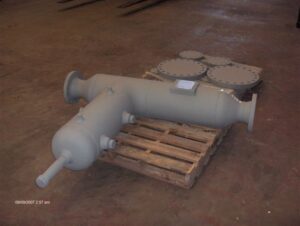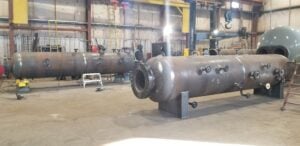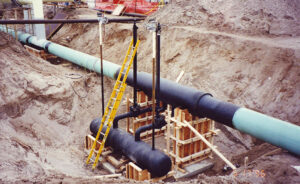In the context of gas pipelines, a “pipeline drip” refers to a vessel or system designed to collect liquids, such as water and hydrocarbons, that condense out of the gas stream. These drips are strategically placed at low points in the pipeline to prevent these liquids from causing operational issues like corrosion or blockages.
While pipeline drips are the traditional method for liquids removal, they don’t come without their downsides. Fortunately, OilPro Oilfield Production Equipment has something that offers the benefits of a pipeline drip while also addressing the issue of annular flow which standard drips don’t:.
Plus, it’s piggable.
We’re talking about Innopipe, the unique inline gas separator and piggable drip system from OilPro that removes 99.9% of liquids.
Innopipe Overview
Innopipe’s patented internals allow dry gas to pass through unimpeded while dropping the free liquids to a quiet collection vessel without forming mist. Annular flow in 3m/s (9.8fps)+ flow regimes traps liquids on walls. Innopipe enables capture of liquids via engineered apertures (doubling as pigging bars) in the primary gas line.
Liquid volumes are dealt with on a site-specific basis. Our custom designs typically deliver in 6-8 weeks after drawing approval for both above and below ground solutions.
Innopipe Has Unique Benefits And Advantages
The Innopipe solution does not need to reduce the gas velocity so efficient liquid separation is achieved in a much smaller vessel.
The liquids seek the path of least resistance and quickly spreads to the exterior walls of the pipe. From here they passively drain to a lower collection vessel where nearly the entire volume of the vessel can be utilized for liquid storage. The result is two smaller vessels using substantially less steel.
The benefits are many, including:
• Smaller vessel means lower cost – often less than ½ the cost of a conventional separator.
• Considerable freight and install costs – again, often greater than ½ as expensive.
• No need for mistex or coalescing filters = more savings + less downtime from plugging.
• Shorter fabrication lead times due to use of readily available pipe in multiple sizes.

A 4 x 6 -285 Innopipe separator. Innopipe separators use patented flow communicating chambers with liquids retained in stabilized reservoir.
Examples of Innopipe Installations and Uses
Innopipe is highly suitable in a wide variety of industrial uses. The Innopipe inline gas separator and piggable drip system is effective in:
-General liquid removal from gas streams.
-Black powder prevention by removing corrosion-causing liquids
-Liquid removal of erosion-causing black powder entrained in liquids
-Liquids protection for inlets of compressor engines.
-Liquids removal before river crossings and low points in pipelines.
-Hilly topography where liquids can collect in low areas, causing slug formation
-Managing slug flow within a pipeline gathering system.
-Cavern storage liquid removal and fill (bi-directional).
-Cavern storage entrained solids removal in collection vessel (solid removal system added)
-Compressor lube oil removal (protection of downstream equipment, lube oil recovery)
-Production and well test separators (size reduction, lower pressure drop, lighter equipment: smaller skids, lower setup/ transport costs, small footprint – can install in existing layouts.)
-Liquids removal before ultrasonic gas meters (accurate measurement, less fouling/ maintenance intervals.)
-Steam condensate removal from steam lines (remove water prior to injection, reduce water loss, reduce heat duty)
-Mitigate upsets in processing plants due to liquid carryover (less gas or liquid phase recycle time, more uptime, lower operations costs)
Next Steps
For more information about the Innopipe inline separator and piggable drip system, please contact OilPro for all global inquiries: 1-403-215-3373 or [email protected].
You can also fill out the Innopipe inquiry form to help us learn more about your specific situation.
We currently have more than 100 global installations of Innopipe and can discuss successes we have seen in North America, Asia, and the Middle East.


